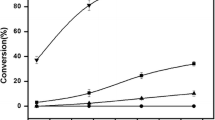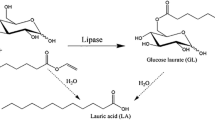Abstract
Phytosterols are regarded as compounds able to reduce total and low-density lipoprotein cholesterol in the blood, and their esterified derivatives could help to improve the effectiveness of this function. In the present study, the water/sodium 1,4-bis-2-ethylhexylsulfosuccinate (AOT)/isooctane reverse micelle (RM) system was set up as a reaction medium for Candida rugosa lipase AY30 (CRL AY30) to synthesize β-sitosterol laurate (β-SLE). The product was identified by TLC, FT-IR, and HPLC–APCI–QqQ–MS/MS and quantified by HPLC. Through stepwise optimization, it was found that CRL AY30 had the highest activity in the water/AOT/isooctane RM system where 50 mM PBS with a pH of 7.5 was adopted as water core to carry CRL AY30, and the proportion of [CRL AY30] (mg/mL), [water] (mM), and [AOT] (mM) was set in 3:375:25, respectively, in isooctane. After screened with single-factor experiments, the esterification reaction conditions in the CRL AY30–water/AOT/isooctane RM system were further optimized by the response surface method as follows: the mole ratio of β-sitosterol to lauric acid of 1:3.5 (25 mM β-sitosterol), the enzyme load of 18% (w/w total reactants), the reaction temperature of 47 °C, and the reaction time of 48 h. As a result, the maximum esterification rate was up to 88.12 ± 0.79%.









Similar content being viewed by others
Abbreviations
- β-SLE:
-
β-Sitosterol laurate
- PSE:
-
Phytosterol ester
- RM:
-
Reverse micelle
- Y%:
-
Yield rate
- AY30–WAI RM:
-
Water/AOT/isooctane RM containing the CRL AY30
References
Moreau, R. A., Whitaker, B. D., & Hicks, K. B. (2002). Phytosterols, phytostanols, and their conjugates in foods: structural diversity, quantitative analysis, and health-promoting uses. Progress in Lipid Research, 41(6), 457–500.
Peterson, D. (1951). Effect of soybean sterols in the diet on plasma and liver cholesterol in chicks. Proceedings of the Society for Experimental Biology and Medicine, 78(1), 143–147.
Pollak, O. (1953). Reduction of blood cholesterol in man. Circulation, 7(5), 702–706.
Pollak, O. (1953). Successful prevention of experimental hypercholesteremia and cholesterol atherosclerosis in the rabbit. Circulation, 7(5), 696–701.
Fernandes, P., & Cabral, J. (2007). Phytosterols: applications and recovery methods. Bioresource Technology, 98(12), 2335–2350.
Qianchun, D., Pin, Z., Qingde, H., Fenghong, H., Fang, W., Mingming, Z., Xiao, Y., Qi, Z., & Chang, Z. (2011). Chemical synthesis of phytosterol esters of polyunsaturated fatty acids with ideal oxidative stability. European Journal of Lipid Science and Technology, 113, 441–449.
Richelle, M., Enslen, M., Hager, C., Groux, M., Tavazzi, I., Godin, J.-P., Berger, A., Métairon, S., Quaile, S., & Piguet-Welsch, C. (2004). Both free and esterified plant sterols reduce cholesterol absorption and the bioavailability of β-carotene and α-tocopherol in normocholesterolemic humans. The American Journal of Clinical Nutrition, 80(1), 171–177.
Hu, L., Llibin, S., Li, J., Qi, L., Zhang, X., Yu, D., Walid, E., & Jiang, L. (2015). Lipase-catalyzed transesterification of soybean oil and phytosterol in supercritical CO2. Bioprocess and Biosystems Engineering, 38(12), 2343–2347.
He, W., Jia, C., Ma, Y., Yang, Y., Zhang, X., Feng, B., & Yue, L. (2010). Lipase-catalyzed synthesis of phytostanyl esters in non-aqueous media. Journal of Molecular Catalysis B: Enzymatic, 67, 60–65.
Jiang, Z., Yu, M., Ren, L., Zhou, H., & Wei, P. (2013). Synthesis of phytosterol esters catalyzed by immobilized lipase in organic media. Chinese Journal of Catalysis, 34, 2255–2262.
Orlich, B., & Schomäcker, R. (2001). Candida rugosa lipase reactions in nonionic w/o-microemulsion with a technical surfactant. Enzyme and Microbial Technology, 28(1), 42–48.
Kamat, S., Beckman, E. J., & Russell, A. J. (1992). Role of diffusion in nonaqueous enzymology. 1. Theory. Enzyme and Microbial Technology, 14, 265–271.
Wang, J.-P., Chen, J.-S., & Zhao, G.-J. (2014). Steady-state and time-resolved spectroscopic investigations on the existence of stable methanol/AOT/n-heptane reverse micelles. Journal of Colloid and Interface Science, 423, 1–6.
Carvalho, C. M., & Cabral, J. M. (2000). Reverse micelles as reaction media for lipases. Biochimie, 82(11), 1063–1085.
Pavlidis, I. V., Gournis, D., Papadopoulos, G. K., & Stamatis, H. (2009). Lipases in water-in-ionic liquid microemulsions: structural and activity studies. Journal of Molecular Catalysis B: Enzymatic, 60, 50–56.
Xue, L., Li, Y., Zou, F., Lu, L., Zhao, Y., Huang, X., & Qu, Y. (2012). The catalytic efficiency of lipase in a novel water-in-[Bmim][PF6] microemulsion stabilized by both AOT and Triton X-100. Colloids and Surfaces. B, Biointerfaces, 92, 360–366.
Cheng, C., Jiang, T., Wu, Y., Cui, L., Qin, S., & He, B. (2018). Elucidation of lid open and orientation of lipase activated in interfacial activation by amphiphilic environment. International Journal of Biological Macromolecules, 119, 1211–1217.
Naoe, K., Ohsa, T., Kawagoe, M., & Imai, M. (2001). Esterification by Rhizopus delemar lipase in organic solvent using sugar ester reverse micelles. Biochemical Engineering Journal, 9, 67–72.
Nagayama, K., Matsu-ura, S.-I., Doi, T., & Imai, M. (1998). Kinetic characterization of esterification catalyzed by Rhizopus delemar lipase in lecithin-AOT microemulsion systems. Journal of Molecular Catalysis B: Enzymatic, 4, 25–32.
Katan, M. B., Grundy, S. M., Jones, P., Law, M., Miettinen, T., Paoletti, R., & Participants, S. W. (2003). Efficacy and safety of plant stanols and sterols in the management of blood cholesterol levels. Mayo Clinic Proceedings, 78, 965–978 Elsevier.
Zeng, C., Qi, S., Li, Z., Luo, R., Yang, B., & Wang, Y. (2015). Enzymatic synthesis of phytosterol esters catalyzed by Candida rugosa lipase in water-in-[Bmim] PF6 microemulsion. Bioprocess and Biosystems Engineering, 38(5), 939–946.
Biasutti, M. A., Abuin, E. B., Silber, J. J., Correa, N. M., & Lissi, E. A. (2008). Kinetics of reactions catalyzed by enzymes in solutions of surfactants. Advances in Colloid and Interface Science, 136(1-2), 1–24.
Lemyre, J.-L., Lamarre, S. b., Beaupré, A., & Ritcey, A. M. (2010). A new approach for the characterization of reverse micellar systems by dynamic light scattering. Langmuir, 26(13), 10524–10531.
Marangoni, A. G. (1993). Effects of the interaction of porcine pancreatic lipase with AOT/isooctane reverse micelles on enzyme structure and function follow predictable patterns. Enzyme and Microbial Technology, 15(11), 944–949.
Wang, H., Jia, C., Xia, X., Karangwa, E., & Zhang, X. (2018). Enzymatic synthesis of phytosteryl lipoate and its antioxidant properties. Food Chemistry, 240, 736–742.
Zou, X.-G., Hu, J.-N., Zhao, M.-L., Zhu, X.-M., Li, H.-Y., Liu, X.-R., Liu, R., & Deng, Z.-Y. (2014). Lipozyme RM IM-catalyzed acidolysis of Cinnamomum camphora seed oil with oleic acid to produce human milk fat substitutes enriched in medium-chain fatty acids. Journal of Agricultural and Food Chemistry, 62(43), 10594–10603.
Reis, P., Holmberg, K., Watzke, H., Leser, M., & Miller, R. (2009). Lipases at interfaces: a review. Advances in Colloid and Interface Science, 147, 237–250.
Yamada, Y., Kuboi, R., & Komasawa, I. (1993). Increased activity of Chromobacterium viscosum lipase in aerosol OT reverse micelles in the presence of nonionic surfactants. Biotechnology Progress, 9(5), 468–472.
Hayes, D. G., & Gulari, E. (1990). Esterification reactions of lipase in reverse micelles. Biotechnology and Bioengineering, 35(8), 793–801.
Correa, N. M., Silber, J. J., Riter, R. E., & Levinger, N. E. (2012). Nonaqueous polar solvents in reverse micelle systems. Chemical Reviews, 112(8), 4569–4602.
Moyano, F., Setien, E., Silber, J. J., & Correa, N. M. (2013). Enzymatic hydrolysis of N-benzoyl-l-tyrosine p-nitroanilide by α-chymotrypsin in DMSO-water/AOT/n-heptane reverse micelles. A unique interfacial effect on the enzymatic activity. Langmuir, 29(26), 8245–8254.
Gao, Y. a., Zhang, J., Xu, H., Zhao, X., Zheng, L., Li, X., & Yu, L. (2006). Structural studies of 1-Butyl-3-methylimidazolium tetrafluoroborate/TX-100/p-xylene ionic liquid microemulsions. Chemphyschem: a European Journal of Chemical Physics and Physical Chemistry, 7(7), 1554–1561.
Avramiotis, S., Stamatis, H., Kolisis, F. N., Lianos, P., & Xenakis, A. (1996). Structural studies of lecithin- and AOT-based water-in-oil microemulsions, in the presence of lipase. Langmuir, 12, 6320–6325.
Pavlenko, I. M., Kuptsova, O. S., Klyachko, N. L., & Levashov, A. V. (2002). The lipase/lipoxygenase bienzyme system in AOT reversed micelles in octane. Russian Journal of Bioorganic Chemistry, 28, 44–49.
Ulbert, O., Fráter, T., Bélafi-Bakó, K., & Gubicza, L. (2004). Enhanced enantioselectivity of Candida rugosa lipase in ionic liquids as compared to organic solvents. Journal of Molecular Catalysis B: Enzymatic, 31, 39–45.
Hossain, M. J., Takeyama, T., Hayashi, Y., Kawanishi, T., Shimizu, N., & Nakamura, R. (1999). Enzymatic activity of Chromobacterium viscosum lipase in an AOT/Tween 85 mixed reverse micellar system. Journal of Chemical Technology & Biotechnology, 74, 423–428.
Katiyar, M., & Ali, A. (2012). Immobilization of Candida rugosa lipase on MCM-41 for the transesterification of cotton seed oil. Journal of Oleo Science, 61(9), 469–475.
Cabrera-Padilla, R. Y., Lisboa, M. C., Pereira, M. M., Figueiredo, R. T., Franceschi, E., Fricks, A. T., Lima, A. S., Silva, D. P., & Soares, C. M. (2015). Immobilization of Candida rugosa lipase onto an eco-friendly support in the presence of ionic liquid. Bioprocess and Biosystems Engineering, 38(5), 805–814.
Li, Y., Ruan, Z., Zheng, M., Deng, Q., Zhang, S., Zheng, C., Tang, H., Huang, F., & Shi, J. (2018). Candida rugosa lipase covalently immobilized on facilely-synthesized carbon nitride nanosheets as a novel biocatalyst. RSC Advances, 8, 14229–14236.
Miletić, N., Abetz, V., Ebert, K., & Loos, K. (2010). Immobilization of Candida antarctica lipase B on polystyrene nanoparticles. Macromolecular Rapid Communications, 31(1), 71–74.
Brzozowski, A., Derewenda, U., Derewenda, Z., Dodson, G., Lawson, D., Turkenburg, J., Bjorkling, F., Huge-Jensen, B., Patkar, S., & Thim, L. (1991). A model for interfacial activation in lipases from the structure of a fungal lipase-inhibitor complex. Nature, 351, 491.
Choi, N., Kim, H., Kim, B. H., Lee, J., & Kim, I.-H. (2017). Production of phytosteryl ester from echium oil in a recirculating packed bed reactor using an immobilized lipase. Journal of Oleo Science, 66(12), 1329–1335.
Le Chatelier, H. L. (1884). Sur un énoncé général des lois des équilibres chimiques. Comptes Rendus de l'Académie des Sciences, 99, 786–789.
Handayani, S., Putri, A. T. T., Setiasih, S. and Hudiyono, S. (2018) Enzymatic synthesis of glycerol-coconut oil fatty acid and glycerol-decanoic acid ester as emulsifier and antimicrobial agents using Candida rugosa lipase EC 3.1. 1.3. IOP Conference Series: Materials Science and Engineering, pp. 012019. IOP Publishing.
Senoymak Tarakcı, M. I., & Ilgen, O. (2018). Esterification of oleic acid with methanol using Zr (SO4) 2 as a heterogeneous catalyst. Chemical Engineering & Technology, 41, 845–852.
Zheng, M., Zhu, J., Huang, F., Xiang, X., Shi, J., Deng, Q., Ma, F., & Feng, Y. (2015). Enzymatic deacidification of the rice bran oil and simultaneous preparation of phytosterol esters-enriched functional oil catalyzed by immobilized lipase arrays. RSC Advances, 5, 70073–70079.
Liu, X., Wang, L., Liu, P., An, N., Chen, G., Zhao, R. and Hang, Z. (2019) Catalytic synthesis of β-sitosterol linolenate by Pickering emulsion-immobilized lipase. E3S Web of Conferences, pp. 02019. EDP sciences.
Hong, S.-C., Park, K.-M., Son, Y.-H., Jung, H.-S., Kim, K., Choi, S. J., & Chang, P.-S. (2015). AOT/isooctane reverse micelles with a microaqueous core act as protective shells for enhancing the thermal stability of Chromobacterium viscosum lipase. Food Chemistry, 179, 263–269.
Cui, C., Guan, N., Xing, C., Chen, B., & Tan, T. (2016). Immobilization of Yarrowia lipolytica lipase Ylip2 for the biocatalytic synthesis of phytosterol ester in a water activity controlled reactor. Colloids and Surfaces. B, Biointerfaces, 146, 490–497.
Funding
The authors acknowledge the funding support from the China National Key R&D Program during the 13th Five-year Plan Period (Grant No. 2016YFD040140402), the National Natural Science Foundation of China (Grant No. 31872890), and the Research Program of Sate Key Laboratory of Food Science and Technology in Nanchang University (Project SKLF-ZZB-201709).
Author information
Authors and Affiliations
Corresponding author
Ethics declarations
This article does not contain any studies with human participants or animals performed by any of the authors.
Conflict of Interest
The authors declare that they have no competing interests.
Additional information
Publisher’s Note
Springer Nature remains neutral with regard to jurisdictional claims in published maps and institutional affiliations.
Rights and permissions
About this article
Cite this article
Chen, S., Li, J., Fu, Z. et al. Enzymatic Synthesis of β-Sitosterol Laurate by Candida rugosa Lipase AY30 in the Water/AOT/Isooctane Reverse Micelle. Appl Biochem Biotechnol 192, 392–414 (2020). https://doi.org/10.1007/s12010-020-03302-0
Received:
Accepted:
Published:
Issue Date:
DOI: https://doi.org/10.1007/s12010-020-03302-0




